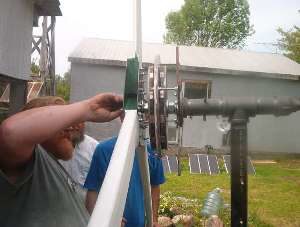
Is it possible to make a wind turbine yourself to generate electricity, or do you have to buy one from a manufacturer or retailer?
Yes, it is possible –
At very least, though, a homemade wind turbine can be fun to build and experiment with, and helps to understand how electromagnetism, electric motors, and generation of wind power work.
Components For The Turbine Itself
There are two main components of a wind turbine. These are rotor blades and an electric motor. A way of attaching the blades to an axle that will spin the motor’s winding currents and magnetic field when the wind blows is also necessary.
Rotor Blades
You can make rotor blades out of any lightweight material, but the easiest way to do it is to use PVC piping. Your rotor blades need to be tilted so as to catch the wind, and piping is already curved in about the right way. Cut the piping into approximately three-
Electric Generator
An electric generator is simply an electric motor in reverse, and that means you can use an electric motor as a generator provide you have some way to induce motion in it –
Not all motors are equally well suited to generate electricity. In fact, opposite considerations often apply in motor design compared to generator design. An electric motor uses electric current to generate motion by applying electromagnetic principles. A generator does the exact opposite: it generates electric current from those same principles from an input of kinetic energy. With an electric motor, usually having a high speed (high RPM) from low power (watts) is desirable. (Note that this isn’t always the case; a motor with lower RPM has more pushing power for a given current, just as your car pushes harder in low gear.)
For an electric generator, though, especially one powered by wind, you want low RPM to result in high wattage. The best motor to use as a generator, therefore, is one that has a low RPM to current ratio. (This still will not be as good as a generator that is built from the start to serve that purpose.)
It will also be necessary to do some online research into electrical circuitry and generators and see how to connect leads to your motor so that current generated by it can be drawn off and used. Once understood, however, this is not especially complicated or difficult.
Mounting Your Turbine
Once your turbine is built and you have satisfied yourself that it can generate power (you can test this by manually spinning the rotor), the next step is to mount it so that it can catch prevailing winds. This requires raising it well above roof height, usually about 30 feet in most areas.
Tower Mounting
The simplest sort of tower mounting raises the entire complex of rotor plus generator on a tower with a secure base. The downside of this arrangement is that maintenance is tricky, with the generator itself lifted high above the ground. Also, since the generator is the heaviest part of the assembly, the tower must be fairly sturdy.
A trickier arrangement is to use a vertical axis wind turbine (VAWT). In this arrangement, your rotor is connected by gears to a drive train that spins a shaft which in turn spins the generator. The generator can be located at ground level with this arrangement, which makes for easier maintenance. However, this does lower efficiency somewhat, as kinetic energy is lost in the transmission.
Rooftop towers for wind turbines can also be purchased. However, you need to make certain that the weight of the entire assembly, including the tower, is within the carrying capacity of your roof.
Using The Power
Since the power produced by your generator is intermittent, you will need a device called a charge controller, along with a storage battery, to make it usable for appliances of any kind. A charge controller keeps the current coming from your generator within safety limits for a storage battery. The battery stores the power and makes it available in a constant voltage.
Net Metering
It is really not recommended that you use home-
It’s a good idea to look into the local laws and policies pertaining to net metering and home electricity generation before trying this to make sure that you can use net metering with home-
